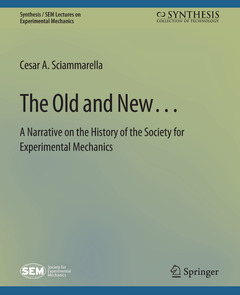The Old and New… A Narrative on the History of the Society for Experimental Mechanics Synthesis / SEM Lectures on Experimental Mechanics Series
Langue : Anglais
Auteur : Sciammarella Cesar A.

The field of Experimental Mechanics has evolved substantially over the past 100 years. In the early years, the field was primarily comprised of applied physicists, civil engineers, railroad engineers, and mechanical engineers. The field defined itself by those who invented, developed, and refined experimental tools and techniques, based on the latest technologies available, to better understand the fundamental mechanics of materials and structures used to design many aspects of our everyday life. What the early experimental mechanician measured, observed, and evaluated were things like stress, strain, fracture, and fatigue, to name a few, which remain fundamental to the field today.This book guides you through a chronology of the formation of the Society for Experimental Mechanics, and its ensuing evolution. The Society was founded in 1935 by a very small group of individuals that understood the value of creating a common forum for people working in the field of Applied Mechanics of Solids, where extensive theoretical developments needed the input of experimental validation. A community of individuals who?through research, applications, sharp discussion of ideas?could fulfill the needs of a nation rapidly evolving in the technological field. The founders defined, influenced, and grew the field of what we now call Experimental Mechanics. Written as a narrative, the author describes, based on input from numerous individuals and personal experiences, the evolution of the New England Photoelasticity Conference to what we know today as the Society for Experimental Mechanics (SEM). The narrative is the author's perspective that invites members of the Society to contribute to the story by adding names of individuals, institutions, and technologies that have defined the Society over the past 75 years.Many of the key individuals who greatly influenced the advancement of the field of Experimental Mechanics are mentioned. These individuals are, in many ways, the founders of the field who have written textbooks, brought their teaching leadership and experiences to the classroom, worked on the Apollo project, and invented testing, evaluation, and measurement equipment that have shaped the fields of engineering. SEM's international membership is highly represented by those in academia, as you will read, although there has always been a powerful balance and contribution from industry and research organizations across the globe.The role of the experimental mechanician is defined, in many ways, through the individual legacies shared in the following pages?.legacies that define the past and create the foundation for what is now and what is to come.
Preface.- Acknowledgments.- Introduction.- The Beginning….- The Illinois Institute of Technology Research Institute (IITRI) Connection.- The Taylor Legacy/Series--The University of Illinois at Urbana Connection.- Other Significant Contributors to SEM.- SESA/SEM Active Members Abroad.- The Role of the U.S. National Laboratories.- SEM's Current Organizational Structure.- Summary.- Authors' Biographies.- Additional Notes.
Cesar A. Sciammarella is Professor Emeritus in the Mechanical, Materials, and Aerospace Department at Illinois Institute of Technology. For 37 years he was the Director of the world-renowned Experimental Mechanics Laboratory of the Illinois Institute of Technology. He is currently an Adjunct Professor at the Department of Mechanical Engineering of the Northern Illinois University. From 1991-1998, Cesar was a Non-Resident Professor at the Universita Degli Study, in Nuoro, Italy. He was Visiting Professor at the following institutions: Polytechnic Institute of Milano (1972, 1976); University of Cagliari (1979); Polytechnic Institute of Lausanne (1979); Univeristy of Poitiers (1980); and Polytechnic Institute of Bari (1992, 1994, 1998, 2003-2008). At the Polytechnic Institute of Bari, he completed a five-year project funded by a personal grant from the Italian government to broaden and revamp the Experimental Mechanics laboratory. After graduation from college, Cesar continued his Ph.D. on the Moire method resulting in the first computer-supported processing of fringe patterns in 1968. He has continued this work in fringe pattern information decoding arriving to self-consistent computer-based algorithms that overcame most of the limiting factors that put constraints on other approaches guaranteeing maximum accuracy and computer efficiency. He applied these different developments to Moire patterns, speckle patterns, holographic patterns in 2D and 3D applications, and MRI patterns. These applications cover a wide spectrum of scales, macro, micro, nanometer, sub-nanometer scales ,and the levels of atomic structures. In 2006, he introduced the detection of optical signals beyond the Rayleigh limit extending holography information recovery at the nano range. Besides working on developing optical techniques applied to experimental mechanics, he has utilized these techniques and other methods of experimental mechanics to solve important engineering problems in the areas of:
Date de parution : 04-2018
Ouvrage de 94 p.
19.1x23.5 cm
Disponible chez l'éditeur (délai d'approvisionnement : 15 jours).
Prix indicatif 21,09 €
Ajouter au panierThème de The Old and New… A Narrative on the History of the... :
© 2024 LAVOISIER S.A.S.



